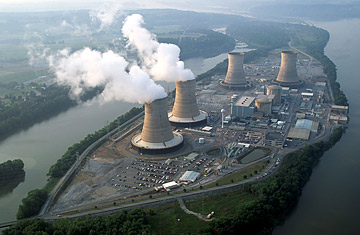
Three Mile Island Nuclear Power Plant
In the dead of night, the hulks of four 372-ft. cooling towers and two high domed nuclear reactor container buildings were scarcely discernible above the gentle waters of the Susquehanna River, eleven miles southeast of Harrisburg, Pa. Inside the brightly lit control room of Metropolitan Edison's Unit 2, technicians on the lobster shift one night last week faced a tranquil, even boring watch. Suddenly, at 4 a.m., alarm lights blinked red on their instrument panels. A siren whooped a warning. In the understated jargon of the nuclear power industry, an "event" had occurred. In plain English, it was the beginning of the worst accident in the history of U.S. nuclear power production, and of a long, often confused nightmare that threw the future of the nuclear industry into question.
There was no panic at the plant, situated on a stretch of muddy soil called Three Mile Island in an otherwise scenic bend in the river. The men in the control room had heard those sirens before. They went about their task of meeting what looked at first like just another "transient," a minor glitch somewhere in the complex system like so many they had dealt with in the past. Unit 2's huge turbine, which generates 880 megawatts of electricity, had "tripped," shut down automatically, as it should when the steam that turns it has somehow been cut off. The technicians assumed that the cause would be easy to find and correct.
They could hardly have been more wrong. For the next several days, radioactive steam and gas seeped sporadically into the atmosphere from the plant. Pennsylvania Governor Richard Thornburgh advised the evacuation of all pregnant women and preschool children living within five miles of Three Mile Island, and thousands of people fled the area. As tension mounted, engineers struggled to cool the reactor's core. There was a genuine danger of a "meltdown," in which the core could drop into the water coolant at the bottom of its chamber, causing a steam explosion that could rupture the 4-ft.-thick concrete walls of the containment building; or the molten core could burn through the even thicker concrete base and deep into the earth. In either case, lethally radioactive gases would be released, causing a nuclear catastrophe.
At week's end officials insisted that while the danger of a meltdown had not vanished, it was receding. Nevertheless, suspense as to the eventual outcome buttressed the claims of nuclear power's foes that all the wondrous fail-safe gadgets of modern technology had turned out to be just as fallible as the men who had designed and built them. Declared Nuclear Power Critic Ralph Nader: "This is the beginning of the end of nuclear power in this country."
